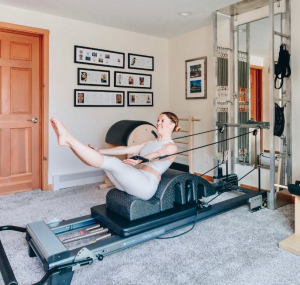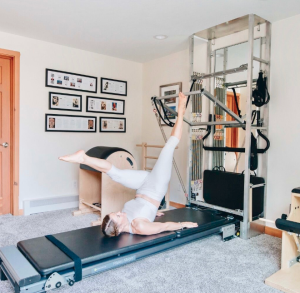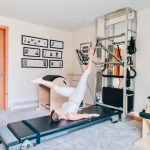Issue #261 – Wednesday, April 24, 2019
Humble Cueing
By Eme Cole
Recently, I was taking a group mat class and about halfway through the class, the instructor proclaimed “People, I am very good at cueing, so if you’re not doing the exercise properly, it’s because you’re not listening!” I was horrified to hear this. First of all, I don’t know if anyone knew to whom she was referring to since, presumably, we were all doing our best to have a good workout. Secondly, I believe that her statement is false. Not specific to her teaching in particular, but to every instructor’s teaching. Yes, some instructors give better cues than others, but it is so subjective relative to the client you are instructing that perfection is a near impossibility.
For group classes, I am most successful when I introduce each exercise in its most basic form and observe the room. If there are a number of students that seem capable of more, I will then suggest intermediate and advanced options to the group. For example: “If you feel comfortable maintaining stability in a high bridge position, you may add an alternating leg lift.” Ideally, the students that are just beginning will know their limits and the more experienced students will incorporate additional variations. I strive to never single anyone out during a group class. It is too great of a risk that they might feel embarrassed and resolve that Pilates isn’t for them. If I notice minor mistakes, I will give a corrective cue to the class as a whole with the hopes that the message is received by those who need it. If there is a significant mistake that could cause an injury, I will certainly correct it immediately in a quiet, helpful tone. I might also consider speaking with an individual after class to suggest that one or two private sessions could really help them get the most out of their group classes.

Every client is unique and could benefit from an individualized program. As an instructor, one’s focus should be to educate, instruct, coach and consult. I find it most effective to begin by defining my role as an instructor versus the client’s responsibilities during their session. For example, explain that you will continually visually assess their alignment and form, whereas they should let you know if something feels awkward, is too difficult, or causes pain. Explain that while you will count their repetitions for them, they should think about their rhythm and that each movement should be equal in both directions. You will suggest breathing patterns for easier execution of specific movements, however they should continue with a natural breath (rather than holding their breath) when no specifications are given. Also, you will adjust the equipment springs, while reminding them to carefully mount and dismount the equipment.
Communication is essential for delivering the appropriate message to accompany each exercise. Proper cueing is one of the most challenging components in teaching Pilates. I find it helpful to gradually introduce the use of Pilates terminology (i.e. differentiating, stabilizing, navel to spine), anatomical terms (i.e. Trapezius, Pectorals, Quadriceps), and specific exercise names (i.e. teaser, short spine, elephant). This will prevent overwhelming your clients with too much initial information. Some clients may be fascinated by exercise science while others may wish to turn their brain off after a long day. Certain clients may prefer general references to body parts while others may want to fully understand the specific muscles in use plus their mind-body connection. Some clients will easily memorize exercise names while others respond best to a description. Read their body language carefully, listen attentively, and observe their natural process. Take the time to assess each person’s needs and focus on the development of their strengths.
Sometimes, even the most carefully worded cues will not get the message across. I find that many new clients (and visual learners) need certain exercises demonstrated for them with proper form and technique during the first few sessions and may then graduate to verbal direction. Other times, I will present a description through words, then try an altered description, and if it’s still not done correctly, I’ll say “would it be okay if I demonstrate this exercise for you?” The important aspect being that I will always take accountability for their successes and their misses. Eventually, I find that cueing alone will become sufficient and my client will be experiencing the full workout rather than observing it.

I prefer not to touch any client in order to address an issue. When I was first studying Pilates, I had an instructor who regularly poked me in the buttocks whenever I wasn’t properly activating my gluteus muscles. It always made me feel a little uncomfortable. Since the most common Pilates areas to poke might also be sensitive ones for many clients (buttocks, pelvis, ribcage, etc.), I have the client place their hands on the area in question and feel for themselves the difference between proper and improper form along with correct muscle activation. This also empowers them to be in control of their body and to better understand exactly how the movement should feel.
The one thing that I have learned conclusively in my 25 years of fitness instruction is that when a client makes a mistake in the execution of their movement, it is just as likely to be my fault as it is to be theirs. Even though I may have cued the exercise in a way that has worked for various other clients, it may not resonate with this particular client. In that case, it is my responsibility to reassess and communicate in a way they will understand. And frankly, I enjoy this challenge because it continues the evolution of my teaching ability. When a client executes an exercise correctly, I can add that cueing strategy to my list of successful communications. When a mistake is made, I know I have room for improvement and strive to fine-tune my verbiage. By staying humble, I leave room for infinite growth.
 Eme grew up in the Chicagoland area & was an elite level gymnast who received a full athletic scholarship to college. Always passionate about fitness, she earned a BS in Kinesiology, an MS in Exercise Physiology and became Pilates certified through The PhysicalMind Institute. Living in Chicago in 2002, she opened Pilates Plus Cross-Training Studio, which she owned & operated for 12 years. In addition, she owned Jump Ahead Academy, a children’s gymnastics & fitness center, for 4 years. Eme has authored 7 books for Pilates instructors & advanced enthusiasts. This ‘Pilates Expanded’ series is available on Amazon.com. More recently, Eme invented and patented the multi-purpose, space-saving ‘Pilates Unfold’ machine and also became a certified Emergency Medical Technician. Currently residing in Aspen/Snowmass CO, she offers Pilates training, studio consulting, workshops and retreats. You can visit her at http://www.PilatesExpanded.com
Eme grew up in the Chicagoland area & was an elite level gymnast who received a full athletic scholarship to college. Always passionate about fitness, she earned a BS in Kinesiology, an MS in Exercise Physiology and became Pilates certified through The PhysicalMind Institute. Living in Chicago in 2002, she opened Pilates Plus Cross-Training Studio, which she owned & operated for 12 years. In addition, she owned Jump Ahead Academy, a children’s gymnastics & fitness center, for 4 years. Eme has authored 7 books for Pilates instructors & advanced enthusiasts. This ‘Pilates Expanded’ series is available on Amazon.com. More recently, Eme invented and patented the multi-purpose, space-saving ‘Pilates Unfold’ machine and also became a certified Emergency Medical Technician. Currently residing in Aspen/Snowmass CO, she offers Pilates training, studio consulting, workshops and retreats. You can visit her at http://www.PilatesExpanded.com

